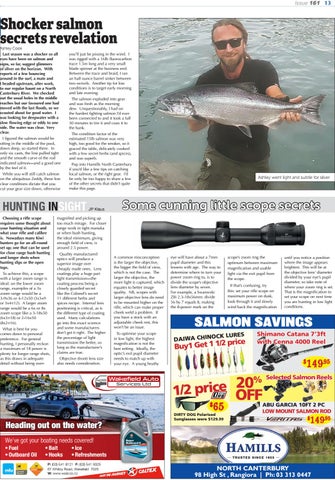Issue 161 13
Shocker salmon secrets revelation Ashley Cook Last season was a shocker so all eyes have been on salmon and signs, so far, suggest glimmers of silver on the horizon. With reports of a few bouncing around in the surf, a mate and I headed upstream, after work, to our regular haunt on a North Canterbury River. We checked out the usual holes in the middle reaches but our favoured one had moved with the last floods, so we scouted about for good water. I was looking for deepwater with a slow flowing edge or eddy to one side. The water was clear. Very clear.
I figured the salmon would be sitting in the middle of the pool, down deep, so started there. In only six casts, the line pulled tight and the smooth curve of the rod indicated salmon—and a good one by the feel of it. While you will still catch salmon on the ubiquitous Zeddy, these low clear conditions dictate that you cut your gear size down, otherwise
you’ll just be pissing in the wind. I was rigged with a 16lb fluorocarbon trace 1.5m long and a very small blade spinner at the business end. Between the trace and braid, I ran an half ounce barrel sinker between two swivels. Another tip for low conditions is to target early morning and late evening. The salmon exploded into gear and was fresh as the morning dew. Unquestionably, I had on the hardest fighting salmon I’d ever been connected to and it took a full 30 minutes to tire it and coax it to the bank. The condition factor of the estimated 15lb salmon was very high, too good for the smoker, so it graced the table, delicately cooked with a few secret herbs (and spices), and was superb. Pop into Hamills North Canterbury if you’d like a few tips on catching local salmon, or the right gear. I’d be only be too happy to share a few of the other secrets that didn’t quite make this page.
HUNTING INSIGHT Choosing a rifle scope requires some thought about your hunting situation and what your rifle and calibre is. Nowadays many Kiwi hunters go for an all-round set up; one that can be used for close range bush hunting and longer shots when hunting slips or the open tops. To achieve this, a scope with a larger zoom range is ideal: on the lower zoom range, examples of a 3x zoom range would be a 3-9x36 or 4-12x50 (3x3=9 or 3x4=12). A larger zoom range would be a 6x or 8x zoom scope like a 3-18x50 (6x3=18) or 2-16x50 (8x2=16). What is best for you comes down to personal preference. For general hunting, I personally reckon a maximum of 18 power is plenty for longer range shots, as this draws in adequate detail without being over-
JP Klaus
Ashley went light and subtle for silver
Some cunning little scope secrets
magnified and picking up too much mirage. For closer range work in tight manuka or when bush hunting, the ideal minimum, giving enough field of view, is around 2.5 power. Quality manufactured optics will produce a superior image over cheaply made ones. Lens coatings play a huge part light transmission—the coating process being a closely guarded secret like the Colonel’s secret 11 different herbs and spices recipe. Internal lens positioning is critical, as is the different type of coating used. Many calculations go into this exact science and some manufacturers don’t get it right. The higher the percentage of light transmission the better, so long as the manufacturer’s claims are true. Objective (front) lens size also needs consideration.
A common misconception is the larger the objective, the bigger the field of view, which is not the case. The larger the objective, the more light is captured, which equates to better image quality. NB, scopes with larger objective lens do need to be mounted higher on the rifle, which can make proper cheek weld a problem. If you have a stock with an adjustable cheek rest, this won’t be an issue. To optimise your scope in low light, the highest magnification is not the best setting. Ideally, the optic’s exit pupil diameter needs to match up with your eye. A young heathy
eye will have about a 7mm pupil diameter and this lessens with age. The way to determine where to turn your power zoom ring to, is to divide the scope’s objective lens diameter by seven. For example, a Swarovski Z8i 2.3-18x56mm: divide 56 by 7 equals 8, making the 8-power mark on the
scope’s zoom ring the optimum between maximum magnification and usable light via the exit pupil from the scope. If that’s confusing, try this: set your rifle scope on maximum power on dusk, look through it and slowly wind back the magnification
SALMON SAVINGS OCK LURES DAIWA CHIN ice
pr Buy1 Get 1 1/2
Shimano Catana 7’3ft with Cenna 4000 Reel
149.95
$
20 e c i r p 1/2 OFF %
65
$
Heading out on the water?
until you notice a position where the image appears brightest. This will be at the objective lens’ diameter divided by your eye’s pupil diameter, so take note of where your zoom ring is set. That is the magnification to set your scope on next time you are hunting in low light conditions.
DIRTY DOG Polarised Sunglasses were $129.99
Selected Salmon Reels
ABU GARCIA 10FT 2 PC LOW MOUNT SALMON ROD $
149.95
We’ve got your boating needs covered! • Fuel • Outboard Oil
• Bait • Hooks
• Ice • Refreshments
P: (03) 541 8121 F: (03) 541 9325 67 Whitby Road, Wakefield 7025 W: www.wasl.co.nz
NORTH CANTERBURY 98 High St , Rangiora | Ph: 03 313 0447
